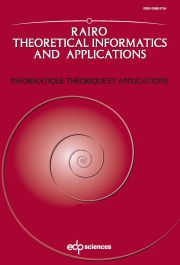No CrossRef data available.
Article contents
Generating Networks of Splicing Processors
Published online by Cambridge University Press: 30 July 2012
Abstract
In this paper, we introduce generating networks of splicing processors (GNSP for short),a formal languages generating model related to networks of evolutionary processors and toaccepting networks of splicing processors. We show that all recursively enumerablelanguages can be generated by GNSPs with only nine processors. We also show, by directsimulation, that two other variants of this computing model, where the communicationbetween processors is conducted in different ways, have the same computational power.
Keywords
Information
- Type
- Research Article
- Information
- RAIRO - Theoretical Informatics and Applications , Volume 46 , Issue 4: Special Issue: Non-Classical Models ofAutomata and Applications III (NCMA-2011) , October 2012 , pp. 547 - 572
- Copyright
- © EDP Sciences 2012
References
A. Alhazov, E. Csuhaj-Varjú, C. Martín-Vide
and Y. Rogozhin, About Universal Hybrid Networks of Evolutionary Processors of Small Size,
in Proc. of LATA. Lect. Notes Comput. Sci.
5196 (2008) 28–39. CrossRef
Alhazov, A., Csuhaj-Varjú, E.,
Martín-Vide, C. and
Rogozhin, Y., On the size of computationally
complete hybrid networks of evolutionary processors.
Theor. Comput. Sci.
410 (2009)
3188–3197. Google Scholar
J. Castellanos, C. Martin-Vide, V. Mitrana and
J.M. Sempere, Solving NP-Complete Problems With Networks of Evolutionary Processors, in
Proc. IWANN. Lect. Notes Comput. Sci.
2084 (2001) 621–628. CrossRef
Castellanos, J., Martín-Vide, C., Mitrana, V. and
Sempere, J.M., Networks of evolutionary
processors. Acta Inf.
39 (2003)
517–529. Google Scholar
J. Castellanos, F. Manea, L.F. de Mingo López
and V. Mitrana, Accepting Networks of Splicing Processors with Filtered Connections, in
Proc. of MCU. Lect. Notes Comput. Sci.
4664 (2007) 218–229. CrossRef
Csuhaj-Varjú, E. and
Salomaa, A., Networks of Parallel Language
Processors, in New Trends in Formal Languages – Control, Cooperation and
Combinatorics. Lect. Notes Comput.
Sci.
1218 (1997)
299–318. Google Scholar
Csuhaj-Varjú, E. and
Verlan, S., On length-separating test tube
systems. Natural Comput.
7 (2008) 167–181.
Google Scholar
Csuhaj-Varjú, E.,
Kari, L. and Paun, G., Test tube distributed systems
based on splicing. Comput. Artif.
Intelligence
15 (1996)
211–232. Google Scholar
J. Dassow, F. Manea and B. Truthe, Networks of
evolutionary processors with subregular filters, in Proc. of LATA. Lect. Notes
Comput. Sci.
6638 (2011) 262–273. CrossRef
Drăgoi, C. and Manea, F., On the descriptional complexity
of accepting networks of evolutionary processors with filtered
connections. Int. J. Found. Comput.
Sci.
19 (2008)
1113–1132. Google Scholar
Drăgoi, C., Manea, F. and Mitrana, V., Accepting networks of
evolutionary processors with filtered connections. J.
UCS
13 (2007)
1598–1614. Google Scholar
R. Loos, On accepting networks of splicing
processors of size 3, in Proc. CiE. Lect. Notes Comput. Sci.
4497 (2007) 497–506. CrossRef
Loos, R., Manea, F. and Mitrana, V., On small, reduced, and fast
universal accepting networks of splicing processors.
Theor. Comput. Sci.
410 (2009)
406–416. Google Scholar
F. Manea, C. Martín-Vide and V. Mitrana,
Accepting Networks of Splicing Processors, in Proc. of CiE. Lect. Notes Comput.
Sci.
3526 (2005) 300–309. CrossRef
Manea, F., Martín-Vide, C. and
Mitrana, V., Accepting networks of splicing
processors : complexity results. Theor. Comput.
Sci.
371 (2007) 72–82.
Google Scholar
F. Manea, C. Martín-Vide and V. Mitrana, Accepting
networks of evolutionary word and picture processors : A survey, in Scientific
Applications of Language Methods, edited by Carlos Martín-Vide.
Mathematics, Computing, Language, and Life : Frontiers in Mathematical
Linguistics and Language Theory
2 (2010) 525–560.
M. Margenstern, V. Mitrana and M.J.
Pérez-Jiménez, Accepting Hybrid Networks of Evolutionary Processors, in Proc. of
DNA. Lect. Notes Comput. Sci.
3384 (2004) 235–246. CrossRef
C. Martín-Vide and V. Mitrana, Networks of
evolutionary processors : Results and perspectives, in Molecular Computational
Models : Unconventional Approaches (2005) 78–114. CrossRef
G. Paun, G. Rozenberg and A. Salomaa, DNA
computing – new computing paradigms. Texts in Theor. Comput. Sci.
Springer (1998).
G. Rozenberg and A. Salomaa, Handbook of
Formal Languages. Springer-Verlag, New York, Inc., Secaucus, NJ, USA (1997).

